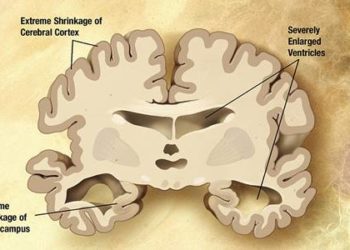Functional connectivity similar between autosomal dominant and late onset Alzheimer Disease
1. Functional MRI images change in similar ways during the progression of both late-onset Alzheimer disease and autosomal dominant (inherited) Alzheimer disease.
2. This study suggests that functional MRI images may be useful in research of treatments for Alzheimer disease, and that study of the autosomal dominant form may provide insight into the mechanisms underlying the late-onset form.
Evidence Rating Level: 2 (Good)
Study Rundown: Alzheimer disease is the most common cause of dementia, and while the majority of cases of Alzheimer disease is caused by a combination of genetic and environmental factors, a specific subtype of Alzheimer disease is known to be caused by certain mutations which result in autosomal dominant Alzheimer disease (ADAD), which presents earlier in life than the more common ‘late-onset Alzheimer disease’ (LOAD). This study sought to evaluate disease progression through a modality called resting-state functional connectivity magnetic resonance imaging (rs-fcMRI), which compares the strength of an oxygen-dependent signal between brain areas that interact and network with each other.
This study found similarities on rs-fcMRI changes between ADAD and LOAD. This modality could therefore be used as an end-point to assess the efficacy of potential interventions for both disease states. The similarity of imagining findings also suggests that ADAD may be similar enough to LOAD to provide a basis for further investigation of the pathogenesis of LOAD. In general, this study was limited by slightly different scanning techniques used between the ADAD and LOAD cohorts. The authors claim that despite these differences they were able to effectively demonstrate similarities between ADAD and LOAD. The older age of LOAD patients may present a confounding variable, although the study attempted to adjust for age differences between the two cohorts.
Click to read the study, published today in JAMA Neurology
Relevant Reading: Dominantly Inherited Alzheimer Network. Clinical and biomarker changes in dominantly inherited Alzheimer’s disease
In-Depth [cross-sectional cohort]: Data regarding a group of patients with ADAD was obtained via the international Dominantly Inherited Alzheimer Network, and patients at risk for LOAD were studied based on data from the Knight Alzheimer Disease Research Center at Washington University in St. Louis. The demographics of these cohorts were compared using independent linear mixed models, revealing a significant difference in age between patients with ADAD (mean ages for different disease severities were between 30.9-49.4 years old) and LOAD (68.7-70.1 years old). Experienced clinicians were asked to assess patients using a structured rating scale called the Clinical Dementia Rating (CDR). Apolipoprotein E Ɛ4 allele status was determined using peripheral blood.
Rs-fcMRI was performed, and Blood-Oxygen-Level Dependent (BOLD) signal data was extracted for thirty-five brain regions, called resting state networks (RSNs), including areas implicated in Alzheimer disease related functional decline. The results indicate that a worsening Clinical Dementia Rating (CDR) score was associated with a decrease in functional connectivity as assessed by rs-fcMRI in both ADAD and LOAD in multiple RSNs. Both ADAD and LOAD showed similar functional connectivity changes with respect to CDR. An ordinal logistic regression model in ADAD was able to predict LOAD CDR scores much better than chance (P<0.001). However, the CDR effect was greater in ADAD as compared to LOAD in several RSNs.
Image: PD
©2012-2014 2minutemedicine.com. All rights reserved. No works may be reproduced without expressed written consent from 2minutemedicine.com. Disclaimer: We present factual information directly from peer reviewed medical journals. No post should be construed as medical advice and is not intended as such by the authors, editors, staff or by 2minutemedicine.com. PLEASE SEE A HEALTHCARE PROVIDER IN YOUR AREA IF YOU SEEK MEDICAL ADVICE OF ANY SORT.







